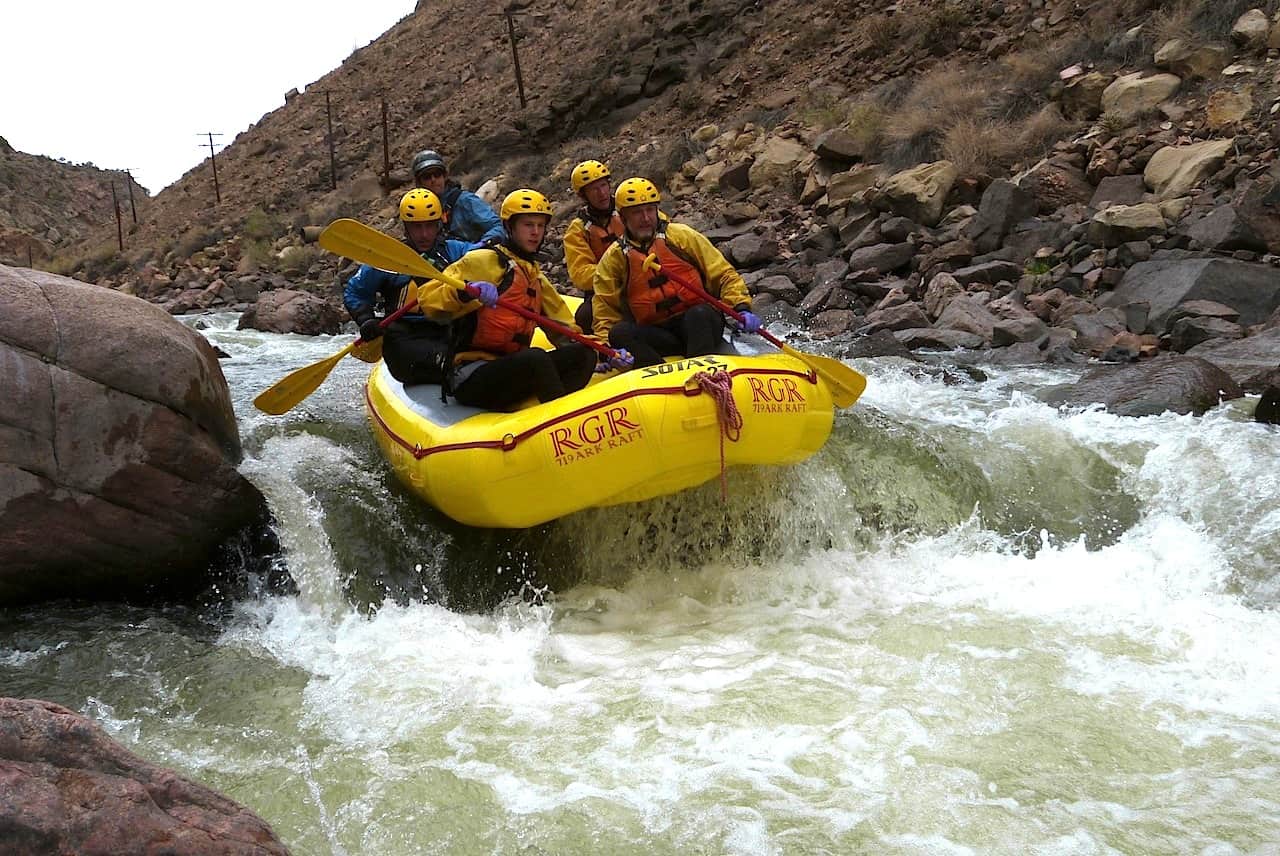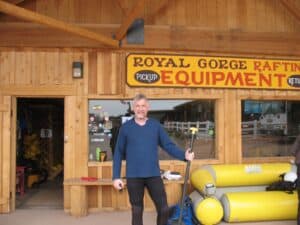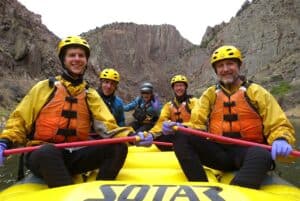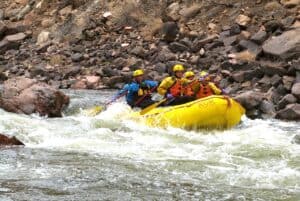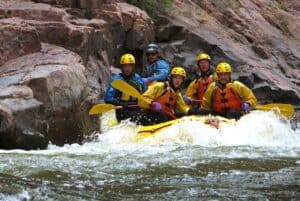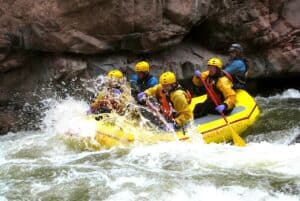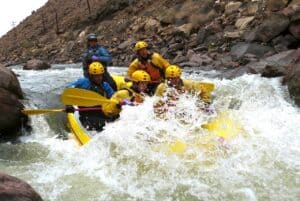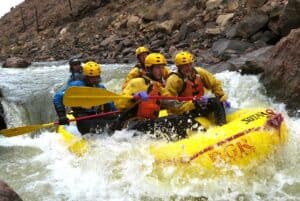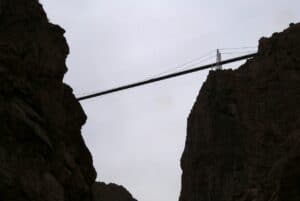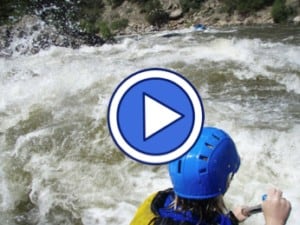When I told my friend Gray that the final drop-off in the Wolf River rapids in central Wisconsin was a Class IV, he scoffed. He was of the opinion that any river that could be run by inexperienced rafters, many of them unable to paddle in a straight line and a good many of them drunk, could not possibly have whitewater rafting comparable to those found in the wild, untamed rivers of the West. That’s when I told him that rapids are graded by vertical drop. It was the main criteria by which rapids are graded, I said. I insisted upon it. I had no idea why.
I do this. I make declaratory statements with only the thinnest thread of knowledge on subjects I know little about. Usually I do it to add luster to a story I’m telling. I do it almost unconsciously with no malice aforethought and the assertion is usually buttressed by some vague recollection of something I read once. Which means it stands a reasonable chance of being true.
So when friends like Gray challenge me, saying things like, “You’re full of shit,” my immediate response is “Look it up.”

Carrying our vessel to the river, our guide Jimmy hoisting his drink in salute to our coming adventure.
Taken Down a Notch
This “looking it up” business actually works well for me because if the person takes me up on it, one of two outcomes ensue: 1.) I am proven wrong and in the course of things learn the correct answer, deepening my knowledge on the subject in a way that roots it in my memory so I can whip it out in the future to bludgeon someone else with, or 2.) I am proven correct, which I enjoy just as much.
The other possibility, and the one that occurs most often, is that the challenger doesn’t have the time or inclination to look it up, which leaves him (and me) uncertain of whether it is correct or not. An unintended consequence of this outcome is that if the assertion seems plausible enough it gets passed on.
Thus, I have had the meta-experience of being confronted with my own dubious pronouncements. Whereupon I always say in a friendly but firm manner, “That’s bullshit.” And when the person asks me how I know it’s bullshit, I say, “Believe me, I know.”
But I don’t know. Until somebody looks it up, I don’t really know. Which is why, after Gray failed to follow through, I went online and looked it up, and I can tell Gray right here and now that he missed an opportunity to take me down a notch.
The grading of rapids has only peripherally to do with vertical drop. It’s more a mix of factors like the number or rocks and the power of the water, the upshot of which is the likelihood of your getting through them without getting seriously injured or killed.
And so I found myself on the Arkansas River in Colorado’s Royal Gorge becoming more thoroughly acquainted with Class III, IV and V rapids.
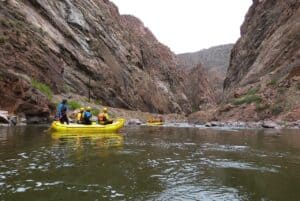
The first thing that happens as you slide out on the water is the command drill. You learn how to paddle in unison on command, and you learn what to do when a man goes overboard.
Near Death Experience
I had come to brave the river with three other fellows, T.J., Nate and Bob, and Jimmy, our guide of 20 years experience who hailed originally from Wisconsin. Jimmy had cut his teeth on the Wolf River and was familiar with the final drop-off, which Gray had poo-pooed, and confirmed that it was indeed a nasty a piece of water, although he stopped short of naming its class.
I was keen to communicate the severity of that stretch to Gray for two reasons. First, I knew Gray was familiar with it, so it was a good point of comparison when talking about other rapids, and, second, I had nearly killed myself on it. I had been thrown out of the boat, falling into the fast moving current and slamming backwards into a rock.
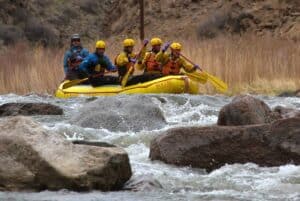
We heard the babble of water over rocks, glimpsed the approaching glimmer and splash, felt the current accelerating and dug in.
The worst thing that can happen when you’re floundering around in the rapids is to get turned around backwards. Depending on the speed of the water, impacting a rock can be like getting hit with a baseball bat, and if you’re about to get hit by a baseball bat, you prefer not to get hit in the back.
When I slammed into that rock it was a horrible shock, and for a moment I was convinced I had broken my spine. Since then, I have made a concerted effort to remain in the boat when rafting. But of course that’s easier said than done sometimes, which is what makes river rafting so scary, and so thrilling.
Learning the Drill
The first thing that happens as you slide out onto the Arkansas River to go whitewater rafting is the command drill. You learn what “hard-right” and “hard-left” mean (basically paddling like crazy on one side or the other), “all forward” or “all back” (padding in unison to move the boat forward or back) and “over-right” and “over-left” (everybody pile onto one side of the boat to dislodge it from a rock). You also learn what to do when somebody goes overboard.
The guide stands at the helm and shouts these directions over the roar of the river and it’s your job as one of four oarsmen to carry them out. If you work together, acting deftly and with authority you can avoid colliding with rocks, getting caught in eddies, being swamped in backflows or breached. The idea is to slip through narrow passageways, slide over the crowns of submerged boulders, ride over gushing rooster tails, spin away from swirling whirlpools and dig like crazy through tumbling stretches of furious whitewater without mishap.
Sledgehammer
We pushed off from the Parkdale Access ramp near where the Atchison, Topeka and Santa Fe Railroad hugs the river’s edge as it snakes through the canyon. We floated placidly along, practicing our command drill until we heard the babble of water over rocks and felt the current picking up. We dug in.
The first rapids we came to were Class III rapids with enough spunk to get our blood pumping. They presented us with a frothing mish-mash of moderate, irregular waves, easily maneuverable, and some menacing rocks, but nothing we couldn’t steer around. A quarter mile on and we came to Pumphouse Rapids, a Class III-IV that featured some powerful but predictable whitewater. And then we came upon Sledgehammer, the first IV-V on this stretch of the river.
To get an idea of the intensity of a Class IV-V rapid consider that there are only six grades of rapids in the hierarchy, with Class VI being the highest. Class VI rapids are for experts only, can only be run at favorable water levels, and require the utmost in skill and precision. A Class V is one notch below that.
Now Jimmy told us to look sharp. The water bucked and churned. We had to dig hard to avoid being carried into a pair of jagged rocks and strove mightily to fit the boat through a boulder sleeve that fell off precipitously at the end.
Next up were The Narrows, a long Class III-IV consisting of three separate drops, tricky to navigate because the river thins to a 30-foot wide channel. But we made it through. We were working well together. Jimmy was proud of us, and we began to strut and boast. And then we came to Wall Slammer.
Wall Slammer
Wall Slammer is nasty IV-V rapid, not for the faint of heart. It was at Wall Slammer we lost Bob. The boat pitched down a chute and we all leaned back, and then we glanced off a boulder, which sent us into a spin before slamming into a rock that caused a jolt that pitched Bob into the drink. When a man goes overboard, your adrenaline spikes. If you act fast, you can grab him and haul him back in, but if you miss your chance, he’ll be carried through the rapids on his own.
The rescue is made all the more harrowing by the fact that you must leave your oars at the worst possible moment, as you are careening down the river at a furious pace, boat bucking, water flying, obstacles looming in every direction. If the boat hits a rock while you’re leaning over to haul him in, more people are going in. Then you’re faced with the awful predicament of more people outside the boat than in it.
Jimmy yelled for T.J. and I to keep paddling as he and Nate grabbed Bob under the arms and hauled him up over the gunwale. Bob slithered into the boat and lunged for his oar. We were heading straight for a boulder. Jimmy hollered “All back!” and we started paddling in reverse like madmen. That slowed the boat enough to soften the collision. We bumped the boulder, spun away from it, and entered the channel backwards.
It’s always a little weird to go down a spillway backwards. Your natural tendency is to turn around and have a look, but you realize that if you hit something while you’re turning around you’ll be off balance and thrown in. So you sit looking straight in front of you like a picture of an Indian in a canoe while the boat zooms backwards down the chute. When you finally get the thing turned around again, it’s a great relief. Your heart is racing, sweat is coursing down your brow, and you feel elated.
The Royal Gorge Bridge
After Wall Slammer, the river threaded its way between 1,200 foot canyon walls. High above us we could see the Royal Gorge Bridge. At 955 feet it’s the highest bridge in the United States, and for 70 years until 2001 it was the highest bridge in the world. The bridge wasn’t built for transportation. It was actually built to be a tourist attraction. The bridge doesn’t really go anywhere, but it affords a fine perch to look down at the river and see the lunatics who are trying to run it.
We picked our way through the remaining rapids: Boat Eater, Lion’s Head and The Pipeline. In the end our flirtation with disaster at Wall Slammer was the highlight of our run, and we were all relieved to have survived it.
After saying goodbye to my boat mates, I was curious, so I went back to my hotel and looked up the class ranking of the final drop-off in the Wolf River rapids in central Wisconsin to compare. That particular stretch of whitewater is called Big Smoky Falls and is graded a solid Class IV, just slightly less than Wall Slammer. It had nearly broken my back, so I had a pretty good idea of what Bob was up against when he got tossed into the river.
As it turned out, I was right about what I had told Gray regarding the class of that rapid, although I didn’t know it at the time. I had just been bullshitting. But now I knew the truth, and the truth was alarming.
If you’re going to do this sort of thing, sometimes it’s better not to know. Sometimes it’s better just to plunge right in.
Check it out…
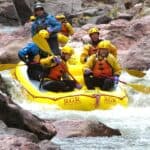 Royal Gorge Whitewater Rafting
Royal Gorge Whitewater Rafting
45045 West US Hwy 50
Canon City, CO 81212
(719) 275 7238
Website
Previous stop on the odyssey: Moab, UT //
Next stop on the odyssey: Dodge City, KS
Image Credits:
All images by Malcolm Logan and Royal Gorge River Rafting, except Baloney on a fork, Joerg Beuge; Pinnochio, Freeteo; Over the shoulder shot, salida.com; No bull, Christos Georghiou

